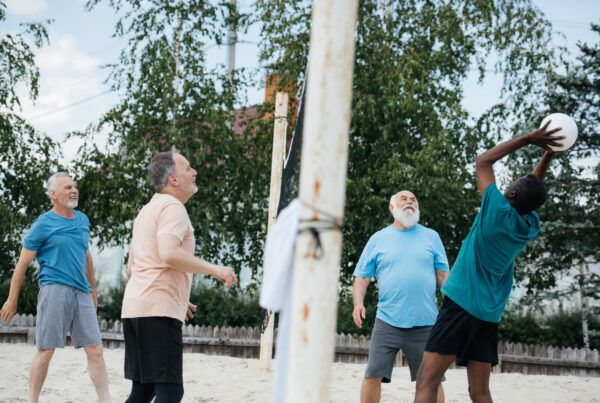”Question: How can exercise improve my mood?
Reading time: 3 Minutes
MWi Hack:
- Learn how exercise can improve your mood on an everyday basis
MWi Summary:
-
- Whether moderate or vigorous, consistent exercise has mood-boosting benefits for people of all skill levels. Here are some activities to consider as you kickstart your fitness plan:
-
-
- Walking
- Aerobic Exercise and weight training
- Low impact exercise
-
The Mind-Body Connection
There’s evidence of a connection between staying active and improved mental health. Studies show people who exercise at least two to three times a week experience significantly less depression, anger and stress than those who exercise less frequently or not at all. And recent research even suggests that over time, regular exercise can help fend off dementia and Alzheimer’s.
Experts are still figuring out exactly why moving your muscles helps boost your mood. One possible explanation could be that aerobic exercise produces endorphins, or “feel good” chemicals. It also increases your heart rate, which triggers norepinephrine, a chemical that may help the brain deal with stress more effectively. Plus, exercise helps to increase blood flow to the brain. This, in turn, impacts all of your cellular functions, everything from improving concentration to regulating sleep to ultimately boosting your mood.
Your daily habits could also play a role, says Alan Schneider, MD, a board-certified psychiatrist and a medical director for Aetna Behavioral Health. “People who exercise regularly have more structured lifestyles,” he explains. “They tend to be more grounded in how they eat, sleep, exercise and maintain themselves, so their mental state tends to be better.”
Mood-boosting exercises
Whether moderate or vigorous, consistent exercise has mood-boosting benefits for people of all skill levels. The American Heart Association and the American College of Sports Medicine recommend doing 30 minutes of moderate-intensity aerobic activity five days a week. If that seems like too much to take on, try starting out with 10- to 15-minute sessions and gradually increasing your time each week. (Always talk to your doctor before starting any fitness program.) Here are some activities to consider as you kickstart your fitness plan.
Walking. “I encourage people to get outside as often as possible,” says Katherine Smith, a registered dietitian nutritionist and Aetna health coach. The extra steps will get your heart pumping. Plus, being out in the sunshine can improve vitamin D levels, which helps ward off depression.
Aerobic exercise and weight training. Both types of exercise increase your heart rate and release feel-good endorphins in the brain. Try doing a combination of both, such as a Zumba class followed by a short session lifting light weights.
Low-impact exercises. Yoga, Pilates or even gentle stretching can improve blood flow to areas that tend to hold tension. (Think your neck and shoulders.) “These exercises provide stretching and controlled breathing, which loosen muscles,” Smith explains. “And the focus on breathing in itself is a great stress reliever.”
That’s what Judy Freedman, 60, discovered several years ago when she took up yoga after the death of her husband and subsequent retirement. “I needed a physical outlet to help me manage the process of change,” she says. Not only has the regular practice improved her flexibility and balance, she says it’s also increased her memory and sense of mindfulness.
Stay on Track
Motivating yourself to get up and get moving can be a challenge, especially if you’re feeling down. Here are a few tips to stay on track.
Find an activity you enjoy. Smith suggests experimenting with different types of workouts until you find the right one for you. “If you don’t like it, you won’t do it,” she points out.
Go at your own pace. If you’re a fitness newbie or have been “on a break” with your workout regimen, consider taking it slowly at first. Kicking off a new routine with short intervals of activity sends positive feedback to your brain that you enjoyed the experience, so you’re more likely to keep up the habit.
Use tech tools. You can use a wearable device to track your steps or activity, and then challenge yourself to improve over time. Or enlist the help of a fitness app. Under Armour’s “Map My Run,” for example, tracks over 600 activities and allows you to share your workouts on social media and connect with other athletes.
Find a workout buddy. You can hold each other accountable for sticking with the routine. Plus, regular workouts can build camaraderie and a sense of community. Blayne Smith, former executive director of Team Red White and Blue, discovered that when he returned to civilian life after the military. Exercise not only helped boost his physical and emotional health, it also provided an important social outlet.






